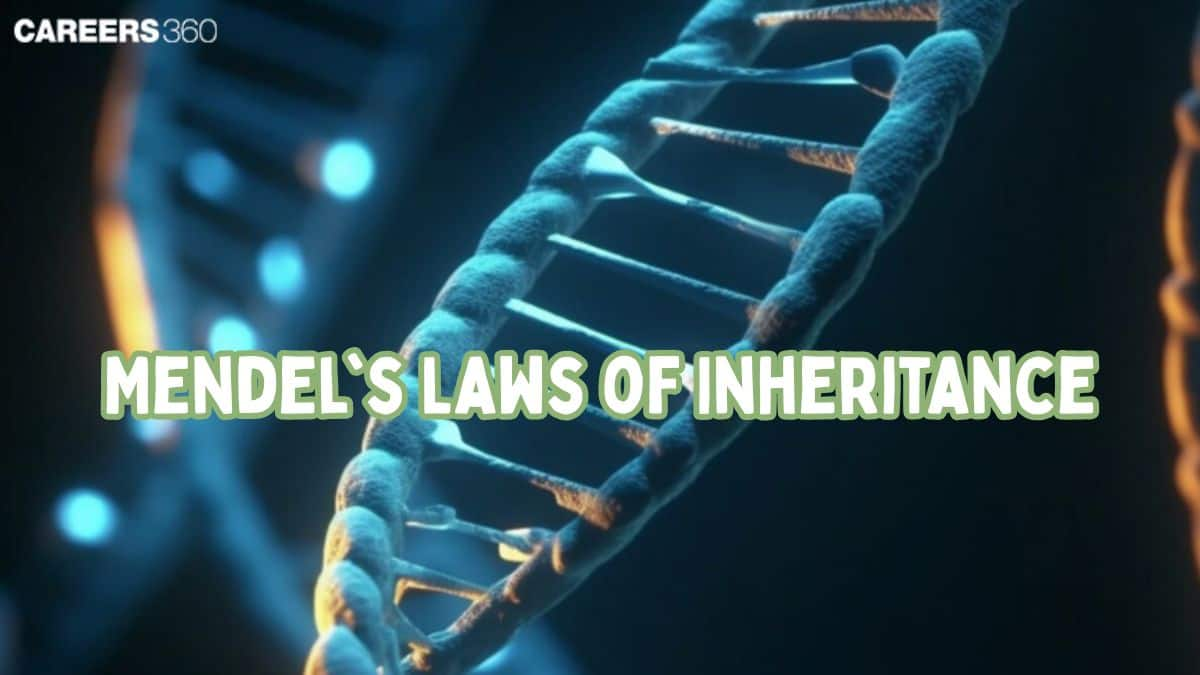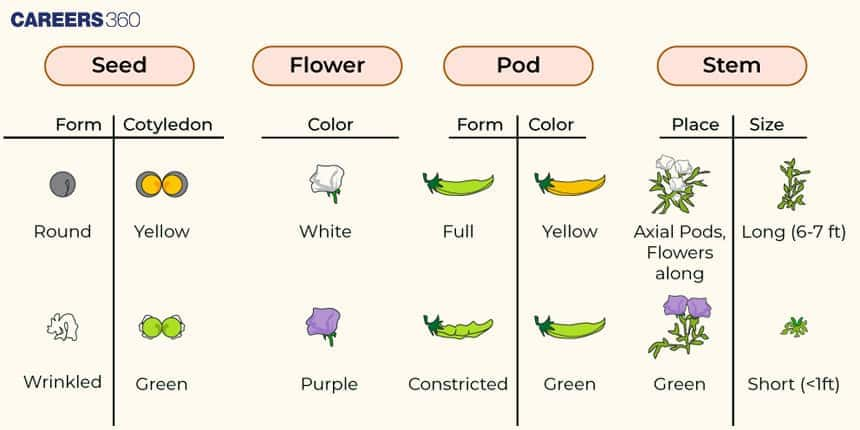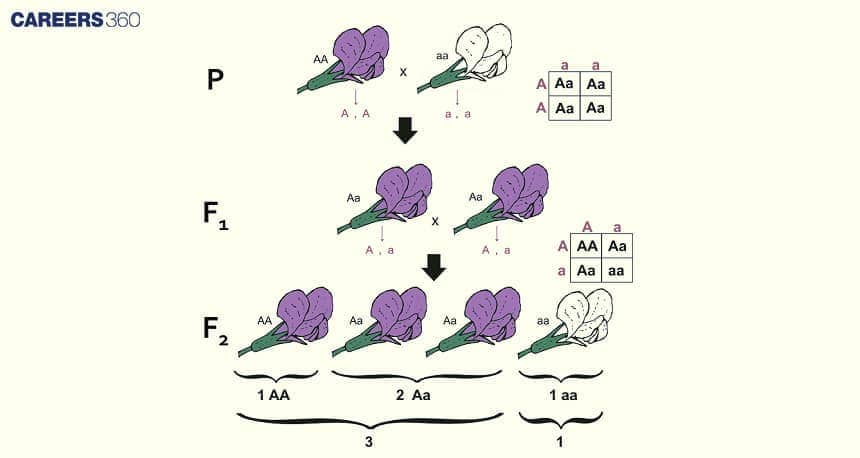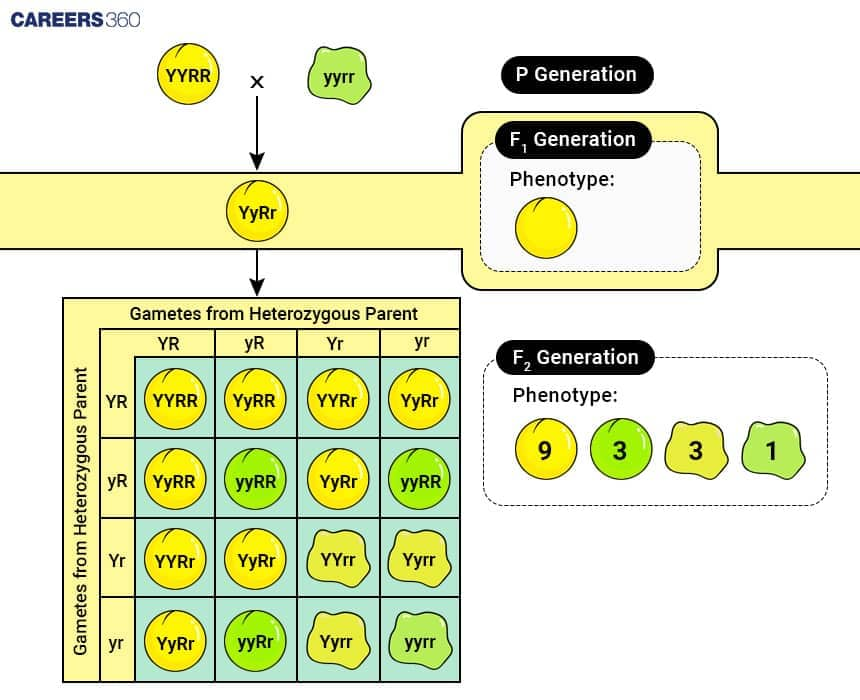Mendel's Laws of Inheritance: definition, Types, Facts, Sources, FAQ
The Mendelian Laws of Inheritance are principles that explain how traits are passed from parents to offspring. It was discovered by Gregor Mendel through his work with pea plants. Mendel identified three Laws of Inheritance: the Law of Segregation, the Law of Independent Assortment, and the Law of Dominance. These laws describe how genes are inherited and how traits can be dominant or recessive in Biology.
This Story also Contains
- What are Mendel's Laws of Inheritance?
- Why did Mendel use Pea Plants in his Research?
- Experiments by Mendel
- Mendel's Laws of Inheritance
- Exceptions and Extensions to Mendel's Laws
- Recommended Video for Mendel’s Law of Inheritance
- MCQs on Mendel’s Law of Inheritance

Mendelian inheritance helps in understanding behavioral genetics, which means how genes can affect behavior. This article includes Mendel's laws of inheritance, Mendel's reason for using pea plants in his research, experiments by Mendel, exceptions and extensions to Mendel's laws, and the conclusion from Mendel's experiments. Mendel's Law of Inheritance is a topic of the chapter Principles of Inheritance and Variation.
What are Mendel's Laws of Inheritance?
Gregor Mendel, known as the "Father of Genetics," was an Austrian monk working with pea plants. The careful work done by Mendel during the middle of the 19th century founded the basic principles of heredity, clearly explaining how traits are passed from generation to generation.
Understanding Mendel's laws is critical in understanding the underlying genetic mechanisms of how traits are passed down. Mendelian Genetics helped in learning how traits pass from parents to offspring. These are fundamental principles that underpin the explanation of many biological events and phenomena, such as the diversity among organisms, metabolism, transmission of Mendelian disorders, and how genetic systems in all living organisms function.
Mendel chose pea plants for his experiments because of various definite, readily recognizable features, such as the color of the blossom or the form of the seed. Over several years, he crossed this plant and carefully noted down how those characteristics passed from generation to generation.
Why did Mendel use Pea Plants in his Research?
Gregor Mendel chose pea plants (Pisum sativum) for his classic experiments in genetics for several major reasons. It is these reasons that turned pea plants into a perfect example for the study of heredity factors:
The Existence of Distinct and Obvious Traits
Some of the traits in pea plants are easy to recognise, such as the flower colour being purple or white; seeds being round or wrinkled and yellow or green; pods being inflated or constricted, and their colour being green or yellow. The flower position is axial or terminal, and the plant height is tall or dwarf.
Short Generation Time
A pea plant has a short life cycle, and Mendel could obtain several generations in one growing season. The short generation time of the study allowed him to collect appreciable data within a very short period, which is very important when considering the study of inheritance patterns over generations.
The ability of Self-Fertilisation
Self-pollination of pea plants means that a single plant is capable of fertilising itself. This property is important in producing purebred, or true-breeding, lines, which consistently produce plants with the same characteristics as the parent. Mendel used true-breeding lines so that any changes to the characteristics he observed would be due only to controlled cross-pollination and not a naturally occurring variation.
Easy to Cross-Pollinate
While pea plants acquire the ability to self-pollinate, they can also be cross-pollinated manually. This fact, on which Mendel would base his experiments, makes it possible to control how pea plants are carefully crossed by artificial pollination. It was this control that allowed him to make certain hybrid combinations of plants and examine their resulting offspring.
Large number of Offspring
By the fact that each pea plant yields a large quantity of seeds, Mendel was assured to work on a large sample size in his experiments. This is important in statistics because the effect of random variation would be reduced, hence providing more reliability to the ratios and patterns observed.
Simple Genetic Makeup
For most traits that Mendel worked with, the pea plant has relatively simple genetics; most of them are controlled by single genes with just two alleles, wherein one of the alleles is dominant and the other recessive. It is precisely this simplicity of genetics that tended to enable Mendel to deduce the basic principles of heredity without the complexity of more complicated genetics at work.
Controlled Environment
By growing pea plants in a garden, he would be in a position to control factors of a plant's growth, like soil, water, and light. This control would ensure that the effects of external factors on the growth and reproduction in plants were reduced, and the inheritance patterns witnessed were a factor of genes.

Experiments by Mendel
Gregor Mendel's experiments on pea plants focused on discovering the basics of heredity. Systematic crossbreeding of pea plants with different characteristics allowed Mendel to closely note the results and ratios produced in the following generations. He worked on observing how the traits were passed into the subsequent generation, which formulated the laws of inheritance. Two of his most important experiments included monohybrid and dihybrid crosses. Both had aspects showing the mechanisms of inheritance of the traits and independence of various traits from each other.
Monohybrid Cross
In the monohybrid cross, Mendel investigated the inheritance of traits that consisted of one single trait, for example, flower colour. By crossing breed plants with different traits—for example, purple-flowered plants crossed with white-flowered plants—he noticed that in the first generation (F1), there was totally one parental trait expressed as dominant, and in the second generation, a ratio of 3:1 dominant to recessive traits.

Dihybrid Cross
For the dihybrid cross, Mendel examined the simultaneous inheritance of two different traits in seed form and colour. He crossed the plants with the two different traits—for example, round and yellow seeds with wrinkled and green seeds to demonstrate that they were two entities inherited independently of one another. This included a 9:3:3:1 phenotypic ratio in the F2 generation.

Mendel's Laws of Inheritance
Gregor Mendel laid down the three elementary laws of inheritance after conducting some pioneer experiments with pea plants. These laws explain how characteristics are passed from parents to offspring and give the basic framework regarding genetic variation.
Law of Segregation
The Law of Segregation indicates an organism carries two alleles of each trait that segregate in the formation of a gamete into two different poles hence making each gamete carry only one allele. This explains why offspring get one allele from each parent. Mendel discovered this principle through the monohybrid cross experiments in pea plants. Cross-pollination of plants with two sets of contrasting features, such as flower colour, yielded results in which the F1 generation consisted of only the dominant feature. If the F1 plants were self-pollinated, the resulting F2 would consistently display a 3:1 ratio of the dominant and recessive traits. This pattern was then used to reach the very conclusion that alleles segregate independently, by which Mendel formulated the Law of Segregation.
Law of Independent Assortment
Gregor Mendel formulated the Law of Independent Assortment, which states that alleles for several different traits are distributed to gametes independently of one another. This is true of genes located on different nonhomologous chromosomes, but it is also true for those genes situated on the same chromatid but far enough apart not to be linked. This law was supported by Mendel's dihybrid cross with pea plants as the empirical evidence.
He considered such traits as seed shape and color, controlled by genes on different chromosomes, and found that they segregate independently. This independence led to the development of a 9:3:3:1 predictable phenotypic ratio in the F2 generation, whereby these various trait combinations manifest among offspring in a characteristic proportion. The discovery of this Law of Independent Assortment by Mendel brought out the tenet that genes for different traits are partitioned independently during the production of gametes, which is very instrumental in understanding genetic inheritance.
Law of Dominance
The Law of Dominance refers to the principle describing the interaction of alleles to express the phenotype of an organism, according to Gregor Mendel. It states that when an organism is carrying two different alleles for one of its traits, one allele masks the expression in the phenotype. Hence, it is that the dominant allele expresses the trait and masks the recessive one, which will only be expressed if both alleles are recessive.
Mendel's pea plant experiments set out several excellent examples of both dominant and recessive genes. For example, while studying the flower color trait, the purple flower (dominant trait) always showed up in the F1 generation when it was crossed with white-flowered plants (recessive trait).
Exceptions and Extensions to Mendel's Laws
The laws of inheritance by Gregor Mendel provided some basic foundations for understanding genetic principles. However, succeeding research has given results showing that exceptions and extensions to the laws abound, expressing the complexity of genetic inheritance.
Incomplete dominance
If the heterozygous phenotype is intermediate between the two homozygous phenotypes, the phenomenon is incomplete dominance. A classic example is that of red flowers and white flowers crossing to produce pink-coloured flowers in the next generation.
Codominance occurs when both alleles are expressed in a phenotype, such as the AB blood type, where on the cell membrane are expressed both A and B antigens.
Multiple alleles consist of more than two different alleles for one gene, like the human ABO blood group system.
Polygenic inheritance
Polygenic inheritance refers to a single characteristic being controlled by more than one gene. For example, height and skin colour in humans are determined by polygenic inheritance.
Recommended Video for Mendel’s Law of Inheritance
MCQs on Mendel’s Law of Inheritance
Question: How many true-breeding pea plant varieties did Mendel select as pairs, which were similar except in one character with contrasting traits
4
2
14
7
Answer: Seven pairs of contrasting features were represented by the 14 true-breeding pea plant varieties that Mendel chose. Having the exception of one character having two opposing forms (traits), each pair was identical in every way. Mendel's principles of inheritance were developed as a result of the study of inheritance patterns using these opposing features, such as tall vs. dwarf or round vs. wrinkled seeds.
Hence, the correct answer is option 3) 14.
Question: What was Gregor Mendel's main contribution to science?
He discovered the structure of DNA
He discovered the laws of heredity
He discovered the process of mitosis
He discovered the theory of natural selection
Answer: Gregor Mendel's main contribution to science was the discovery of the laws of heredity.
Through his experiments with pea plants, Mendel was able to establish the basic principles of inheritance and develop a mathematical framework for predicting the probability of certain traits appearing in offspring. His work laid the foundation for the field of genetics and provided a framework for understanding how traits are passed down from one generation to the next. While Mendel's work predated the discovery of DNA and the development of modern molecular genetics, his principles of inheritance remain an important foundation for genetic research today.
Hence, the correct answer is option 2) He discovered the laws of heredity.
Question: Mendel's laws of heredity are based on:
Random chance
Environmental factors
Genetic recombination
Segregation and Independent assortment of alleles
Answer: Mendel's laws of heredity are based on the segregation and independent assortment of alleles. During gamete formation, the two copies of each gene segregate from each other so that each gamete only carries one copy of each gene. Additionally, the inheritance of one gene does not affect the inheritance of another gene, allowing for an independent assortment of traits. Mendel's laws of heredity were derived from careful observations of the inheritance patterns of traits in pea plants, and his experiments showed that these laws could be used to predict the probability of offspring inheriting specific traits. While chance and genetic recombination also play a role in inheritance, Mendel's laws are based on the fundamental principles of segregation and independent assortment of alleles.
Hence, the correct answer is option 4) Segregation and independent assortment of alleles.
Also Read:
Frequently Asked Questions (FAQs)
Mendel's law of inheritances includes the segregation law, the independent assortment law, and the law explaining dominance. All these principles expound and elaborate on how characteristics or rather traits are transferred from parents to their offspring.
Mendel's laws are considered the foundation of classical genetics. If one can understand how traits are passed on from parents to their offspring. Then they can predict genetic outcomes under different scenarios.
Mendel worked on experiments of controlled cross-pollination between pea plants on continuous variations concerning flower colour and seed shape over successive generations.
Examples are cystic fibrosis and Huntington's disease, inherited in patterns predicted by Mendel's laws.